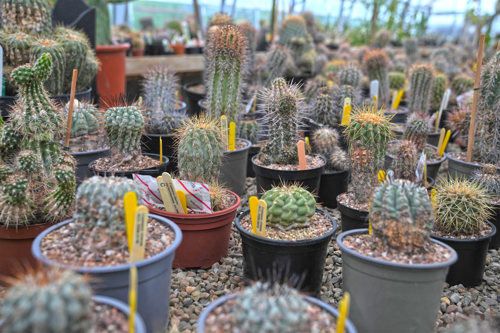
A Plan to Solve a Prickly Problem
Conservationists are joining forces in a plan to save highly threatened cacti.
A new conservation plan outlines measures to support the recovery of Copiapoa cacti, a highly threatened group of plants found only in Chile’s hyper-arid Atacama Desert.
Pablo Guerrero, Researcher at the Institute of Ecology and Biodiversity, Assistant Professor at the University of Concepción’ and member of the IUCN Species Survival Commission (SSC) Cactus and Succulent Plant Specialist Group, said that Copiapoa played a unique role within their habitat.
“The Copiapoa genus is a key ecological component of the desert ecosystems in northern Chile, where it survives thanks to the moisture provided by the coastal fog, known as the camanchaca.
“This rich cactus genus not only serves as shelter and a food source for various species but also contributes to soil stabilisation and the carbon cycle in one of the driest environments on the planet. Their ability to store water and adapt to extreme conditions makes them fundamental for ecosystem resilience.”
Pablo Guerrero
Cacti, which are known for their ruggedness in arid environments and for their arrays of forbiddingly sharp spines, may not initially seem fragile. However, more than two-thirds of the 32 species and seven subspecies that make up the Copiapoa genus are classified as Critically Endangered or Endangered according to the IUCN Red List of Threatened Species (tm).
Some of this is driven by climate change. Copiapoa are highly adapted to survive in the driest non-polar desert on Earth. This level of specialisation means that even the slightest changes in their environment, such as variations in humidity levels, puts their survival in doubt.
Many species tend to have very limited ranges, some can only be found in a single location. It takes decades for Copiapoa to reach an age where they can produce seeds which never travel far from the parent plant. As a result, they are neither able to adapt to a changing climate, nor migrate to new areas where conditions may be more favourable. If a valley that a particular species lives in dries out, that species is likely to become extinct as a result.
This problem is compounded by the illegal collection and trade in cacti, with specimens being taken from the wild for sale to cactus enthusiasts. Industrial and urban building projects and off-road motorsports also cause significant damage to wild populations.
“These plants are exposed to a diverse array of threats in their natural habitat and climate change exacerbates this situation. These are complex issues, but illegal trade can be all but eradicated through effective protection measures.”
Bárbara Goettsch, Co-Chair of the SSC Cactus and Succulent Plants Specialist Group

The conservation plan, which will be implemented over eight years, outlines areas where better environmental protection is needed, coupled with research to better understand threats, and to evaluate the success of conservation actions.
The plan establishes a series of aims, such as promoting improvements to legislation that establishes habitat protection standards for development projects, pushing for at least 50% of endangered Copiapoa populations to be included within protected areas, and empowering people living in these environments to protect the plants from illegal extraction.
“We’re officially listed as the home of the UK National Collection of Copiapoa. They are fascinating because of their adaptations. Cactus have evolved alternative methods of photosynthesis than other plants; their leaves have modified into protective spines, so they use their stems and trunks to absorb light.
Philip Esseen, Head of Plants at Chester Zoo
“The Copiapoa collection at Chester Zoo began because a horticulturalist who worked here years ago had a real passion for cacti. The level of risk that they face underlines the significance of the collection. It’s really good we can look after them ex-situ (outside their natural habitat), keeping them as a living bank of genetic material, propagating them and growing seedlings, and playing a conservation role in the wild.
“Visitors to the zoo are invited to the Plant Project greenhouse, where they can see unusual cactus and other plant species. We want to give a rounded view of the natural world, as plants like Copiapoa are just as unique and as crucial a part of their environment as animals," added Phil.
The new Copiapoa rescue plan is the result of a conservation-planning workshop funded by Chester Zoo, the SSC Internal Grants programme and the British Cactus and Succulent Society and facilitated by the SSC Conservation Planning Specialist Group – Centre for Species Survival Brazil.
Its implementation is being driven by the SSC Cactus and Succulent Plants Specialist Group and Chester Zoo, in collaboration with Chilean public sector organisations including the Ministry of the Environment, the National Forestry Commission, the Chilean Forestry Institute, and the National Agricultural Research Institute’s Intihuasi seedbank, as well as the Cactus Lagarto nursery.
Representatives from these organisations are calling on members of the public to support the plan, regardless of where they live.
“Many people don’t realise that a lot of plant species are threatened by illegal collection and trafficking, so we encourage plant collectors and enthusiasts to check where their plants are coming from.
“You should always buy your plants from reputable nurseries who can provide information on the source of their stock. Also, avoid picking wildflowers and plants, wherever you live; native British species such as the ladies’ slipper orchid have declined as a result of these activities.”
Paul Bamford, Regional Field Programme Manager for Chester Zoo
